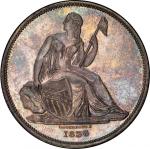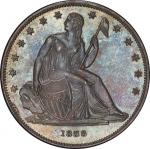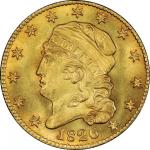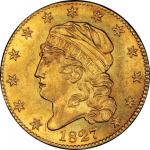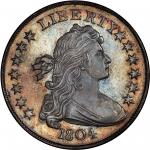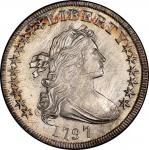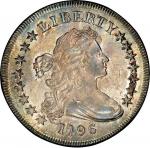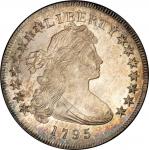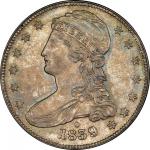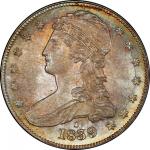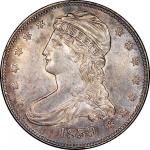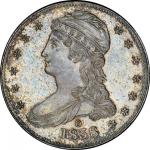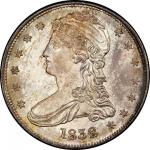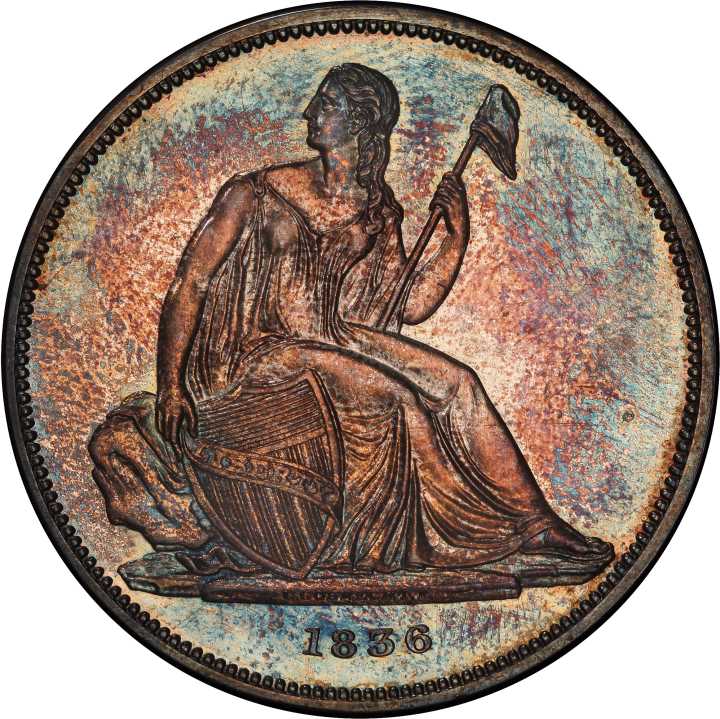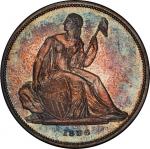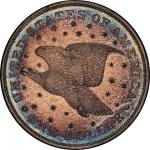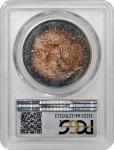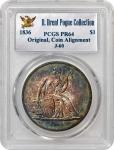Only 1000 of these dollars were stamped: they are, therefore, rarely met with.” — Dr. John L. Riddell, A Monograph of the Silver Dollar, Good and Bad, 1845</em>The unadorned fields of the obverse provide a canvas for rich toning, with gold at the distant peripheries, surrounding a broad if irregular band of pastel blue-green that embraces a center of dappled deep violet, amber, and copper. Hints of silvery brilliance persist around the obverse device. Though the reverse is crowded with design elements, it is no less full of color than the obverse. Bright pastel blue at the rims barely breaks into a ring of violet before evolving to orange and gold at the center. Bright reflectivity beams from the fields. The aesthetic appeal is superb, even as some light hairlines may be found, most prominent in the right obverse field. A thin scratch connects the left base of Liberty’s rock to the denticles beside it, and a particularly long hairline crosses above ONE to the eagle’s talon on the reverse. A tiny nick is noted on Liberty’s forearm near the pole. Scrutiny finds abundant lintmarks on the reverse, the longest of which resembles a cursive L within the space between ON of ONE, but several other shorter ones may be seen on that side. A light lamination is present in the field just below the eagle’s belly. The strike is firm, with a small area of localized softness on a few feathers on the eagle’s side, below his wing. A raised line above the eagle represents the only remains of a clash that are substantial enough to be visible to the naked eye.Since dollar production was suspended in 1804, the silver dollar denomination had become unfamiliar in commerce in the decades preceding 1836, though Spanish 8 reales and other world coins of silver dollar size continued to circulate throughout the United States. In 1831, when the tide of bullion outflows to the Far East began to make the market for a domestically circulating dollar coin possible again, the ban on dollar production was lifted and the possibility of a dollar coin was reconsidered. With engraver William Kneass in poor health, the Mint was forced to wait until after the June 1835 appointment of Christian Gobrecht as assistant or “second” engraver. Gobrecht received design assistance from two of America’s best known painters, Thomas Sully, who offered sketches of a seated figure of Liberty with cap and pole, and Titian Peale, who submitted several sketches of a “naturalistic eagle” whose flight was described by Mint Director Robert M. Patterson as “like the country of which it is the emblem, its course onward and upward.” Gobrecht refined Sully’s concept for the obverse and Peale’s concept for the reverse, to which he added 26 stars, 13 large ones for the original colonies and 13 smaller ones for subsequent states, apparently anticipating the January 1837 entry of Michigan to the Union.Dating Gobrecht dollars hinges upon their die alignment and die state. This example is struck in Die Alignment I, standard coin turn with the eagle pointing upward, marking it as an original striking from late 1836. The head of Liberty is opposite DO of DOLLAR. In this alignment, the pellet preceding ONE, on the left side of the reverse, is on a slightly lower plane than the pellet following DOLLAR on the right side of the reverse. The die state is equivalent to Dannreuther-Teichman-Sholley State H, showing the peripheral die markers located on the rim and among the denticles, and displaying a die scratch through O of ONE.Long considered a pattern, modern numismatists recognize that the 1,000 Gobrecht dollars struck before December 31, 1836 were coined to serve in circulation. The Mint even conducted something of a press campaign on the new coin, as descriptions of “a new dollar of our own Mint” were published in New York as early as December 15, 1836, and spread nationwide over the course of the following month. Though 1836 Gobrecht dollars are called Proofs today because of their reflective surfaces, only a small group were set aside for presentation, including the example Mint Director Robert M. Patterson donated to the American Philosophical Society on December 16, 1836, and a small group purchased by President Andrew Jackson, one of which was offered most recently in 2002. The Korein-47 specimen at the American Numismatic Society has been called the “one true Proof” by John Dannreuther, Saul Teichman, and Craig Sholley. Most examples show significant wear, and gems are extremely rare. PCGS has never certified an example finer than Proof-64. PCGS# 11225. NGC ID: 27YF.

